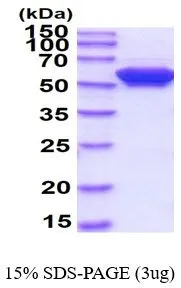
3 microg of GTX66995-pro Human FKBP4 protein (active) by SDS-PAGE under reducing condition and visualized by coomassie blue stain
Human FKBP4 protein, His tag (active)
GTX66995-PRO
Product group Molecular Biology
Overview
- SupplierGeneTex
- Product NameHuman FKBP4 protein (active)
- Delivery Days Customer9
- Application Supplier NoteSpecific activity is > 700 nmol/min/mg, and is defined as the amount of cleaves 1nmole of suc-AAFP-PNA per minute at 37C in Tris-HCl (pH 8.0) using chymotrypsin.
- ApplicationsFunctional Assay
- CertificationResearch Use Only
- Concentration1 mg/ml
- ConjugateUnconjugated
- Scientific DescriptionThe protein encoded by this gene is a member of the immunophilin protein family, which play a role in immunoregulation and basic cellular processes involving protein folding and trafficking. This encoded protein is a cis-trans prolyl isomerase that binds to the immunosuppressants FK506 and rapamycin. It has high structural and functional similarity to FK506-binding protein 1A (FKBP1A), but unlike FKBP1A, this protein does not have immunosuppressant activity when complexed with FK506. It interacts with interferon regulatory factor-4 and plays an important role in immunoregulatory gene expression in B and T lymphocytes. This encoded protein is known to associate with phytanoyl-CoA alpha-hydroxylase. It can also associate with two heat shock proteins (hsp90 and hsp70) and thus may play a role in the intracellular trafficking of hetero-oligomeric forms of the steroid hormone receptors. This protein correlates strongly with adeno-associated virus type 2 vectors (AAV) resulting in a significant increase in AAV-mediated transgene expression in human cell lines. Thus this encoded protein is thought to have important implications for the optimal use of AAV vectors in human gene therapy. The human genome contains several non-transcribed pseudogenes similar to this gene. [provided by RefSeq, Sep 2008]
- Storage Instruction-20°C or -80°C,2°C to 8°C
- UNSPSC12352204
